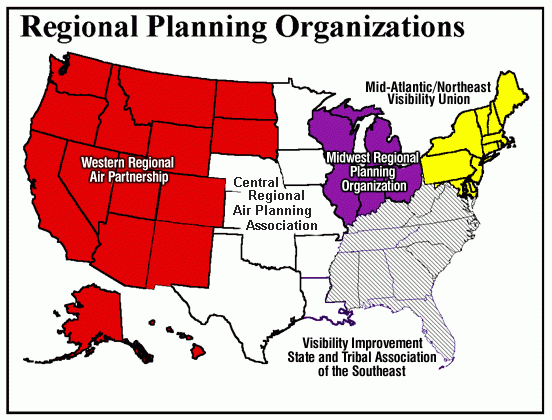Visibility - Regional Planning Organizations
Because the pollutants that lead to regional haze can originate from sources located across broad geographic areas, EPA has encouraged the States and Tribes across the U.S. to address visibility impairment from a regional perspective. These organizations evaluate technical information to better understand how their States and Tribes impact national parks and wilderness areas (Class I areas) across the country, pursue the development of regional strategies to reduce emissions of particulate matter and other pollutants leading to regional haze, and help states meet the consultation requirements of the Regional Haze Rule.
The five regional planning organizations are:
Western Regional Air Partnership (WRAP).Exit The WRAP is the successor organization to the Grand Canyon Visibility Transport Commission, which was formed in 1991 and issued recommendations to EPA in 1996 for improving the air quality in the 16 Class I areas on the Colorado Plateau. The Western States Air Resources Council (WESTAR) is working in cooperation with the WRAP. Nine WRAP states (Arizona, California, Colorado, Idaho, Nevada, New Mexico, Oregon, Utah, Wyoming) now have the option of implementing many of the Commission's recommendations within the framework of the national regional haze rule.
Central Regional Air Planning Association (CENRAP).Exit Affiliated with the Central States Air Resource Agencies (CENSARA). Includes nine states - Nebraska, Kansas, Oklahoma, Texas, Minnesota, Iowa, Missouri, Arkansas, and Louisiana.
Midwest Regional Planning Organization (Midwest RPO). Affiliated with the Lake Michigan Air Directors Consortium (LADCO).Exit Includes five states - Illinois, Indiana, Michigan, Ohio, and Wisconsin.
Mid-Atlantic/Northeast Visibility Union (MANE - VU).Exit Includes Connecticut, Delaware, the District of Columbia, Maine, Maryland, Massachusetts, New Hampshire, New Jersey, New York, Pennsylvania, Rhode Island, Vermont, Northern Virginia, and suburbs of Washington, D.C. The Northeast States for Coordinated Air Use Management (NESCAUM) and Mid-Atlantic Regional Air Management Association (MARAMA) are working in cooperation with the OTC on regional haze issues.
The Visibility Improvement State and Tribal Association of the Southeast (VISTAS)Exit is a collaborative effort of state governments, tribal governments, and various federal agencies established to initiate and coordinate activities associated with the management of regional haze, visibility and other air quality issues in the Southeastern United States. Member States and Tribes include: the States of Alabama, Florida, Georgia, Kentucky, Mississippi, North Carolina, South Carolina, Tennessee, Virginia, and West Virginia and the Eastern Band of the Cherokee Indians.

